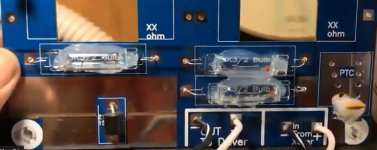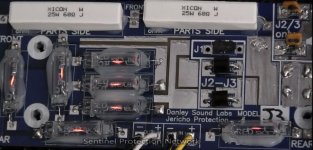particularly the ones I'm considering, is very low in the calculated range of 0.2~0.3 ohms, and likely less than that.
so, parallel assembly?
0,2 // 0,2 = 0,1
0,2 // 0,2 // 0,2 // 0,2= 0,05
You may need to check if lamp can resist the current cycle of a woofer, instant current maybe break its filament
so, parallel assembly?
0,2 // 0,2 = 0,1
0,2 // 0,2 // 0,2 // 0,2= 0,05
Unfortunately it doesn't pay off to do that, based on what I've read so far (I'm no expert on this, but some of it seems pretty straightforward).
First of all, the hold current rating will increase for each PTC that you add in that parallel arrangement, which means that unless you plan to ensure that the TOTAL hold current capacity is what you're aiming for, the parallel PTC combo won't offer the protection that you're expecting. Secondly, the resistance of a PTC goes down as its hold current rating goes up, so it's just cheaper and easier and just as effective to deploy one large PTC rather than multiple smaller ones to achieve the same hold current capacity.
That kind of protection requires a series resistance, something you want to avoid with woofers.
That depends on how much current the diodes can handle. The resistor is there for protection of the diode, but if they can handle the current, your fine.
Put the circuit before the amp and you can use el cheapo diodes. The article has info on this.
That depends on how much current the diodes can handle. The resistor is there for protection of the diode, but if they can handle the current, your fine.
I think that the resistor is there for more than that. If there was no resistor there, there would be no voltage divider circuit (resistor + device to be protected) and therefore no protection for the device that is in parallel with the diodes.
Here are some actual resistance measurements of PTC devices. Note that I said "resistance" not "impedance", as for each device it basically stays constant from 20 Hz to 20kHz.
Hold Current Rating / Resistance
0.50 A - 0.634 Ohms
0.65 A - 0.432 Ohms
0.75 A - 0.354 Ohms
1.10 A - 0.217 Ohms
1.35 A - 0.157 Ohms
...and a "100W Speaker Circuit Breaker" which I suspect is just a PTC in a capsule.
1.50 A - 0.130 Ohms
So from about 1.1 A up, I wouldn't worry about the "cold" impedance of the PTC having any audible impact on a speaker.
Hold Current Rating / Resistance
0.50 A - 0.634 Ohms
0.65 A - 0.432 Ohms
0.75 A - 0.354 Ohms
1.10 A - 0.217 Ohms
1.35 A - 0.157 Ohms
...and a "100W Speaker Circuit Breaker" which I suspect is just a PTC in a capsule.
1.50 A - 0.130 Ohms
So from about 1.1 A up, I wouldn't worry about the "cold" impedance of the PTC having any audible impact on a speaker.
I think that the resistor is there for more than that. If there was no resistor there, there would be no voltage divider circuit (resistor + device to be protected) and therefore no protection for the device that is in parallel with the diodes.
I use this circuit a lot to clip sounds for sound design.
Never needed a resistor.
Also a gazillion guitar pedals use it, no resistor.
Put it before the power amp and you can use $0,10 parts.
Last edited:
I use this circuit a lot to clip sounds for sound design.
Never needed a resistor.
Also a gazillion guitar pedals use it, no resistor.
Put it before the power amp and you can use $0,10 parts.
In those cases, the SOURCE impedance is acting as the resistor.
For example, LINE OUT connections from a line-level source usually have a source impedance of 100 Ohms to 600 Ohms, so yes, you can use that circuit with them without a resistor, as the source resistance is acting the part of the "resistor" in the circuit.
It should not however be used on speaker-level circuits, e.g. across a subwoofer driven by an amplifier, where the source resistance is extremely low. Unless of course you want to see if the diodes burn before the amp goes into protection
Fuse and halogen lamp in parallel? When/if fuse blows, you still get sound through the lamp at limited power.
That should work. Replace the fuse with a PTC and the speaker should return to normal operation by itself without you having to replace a blown fuse.
Bi-amping helps because the design peak (relative to the average power) for a narrow-band of audio is not as high as with an amp that has to be ready for occasional peaks on the full music band. It's a statistical analysis but a realistic challenge for good sound quality.
So you don't need amps with enough headroom to cook a driver just playing warps on a vinyl recording.
Multi-amping helps a whole lot of things.
B.
So you don't need amps with enough headroom to cook a driver just playing warps on a vinyl recording.
Multi-amping helps a whole lot of things.
B.
speaker passive protection circuit
Am sure you have seen these....... trial and error....good luck!Am I on the right track here?
Attachments
Am sure you have seen these....... trial and error....good luck!
Yup. The combination of "lamp protection" and PTC devices appears a lot. In the Bose AM10 Series II system for example, I think every one of the 5 channels had the lamp/PTC protection combo. It makes the system almost foolproof. Almost. There has been the occasional fool who has still managed to blow their Bose systems...
Anyway, when I went by the bar on Sunday (the bar's been running public viewings of the G.O.T. series, and I've been loaning them my Blastoramas for use as the front speakers), I noticed that the house DJ was cranking some tunes and the bar's main system sounded a bit strained. Turned out that it was NOT the bar's main system that was playing, but the background music system. The DJ had turned on the main system's amplified speakers, but had forgotten to turn up the gain for the main system on the mixer and apparently cranked up the background system instead. The bass module for the background system is currently my POC6 50 Hz TL that uses the Dayton Audio PA310 driver rated at 350W, so it was fine, but I don't know how those Bose 101s managed to survive running at that power level so long. The amp's rated to do 125W x 2 into 8 ohm and will happily do more than that into the 60W rated Bose 101's 4 ohm impedance.
Anyway, that experience has me rethinking how I'm going to handle the power protection for my rebuilt subwoofer, particularly as Hornresp says that the sensitivity of the "Enigma 2" is going to be around 92dB/2.83V/1M, a good 5dB below that of the POC6, and the driver's rated to handle 70W (compared to the 350W of the POC6). I was planning to use a 100W "speaker circuit breaker" with the Enigma 2, but I think I'm going to experiment with some inline PTC protection to see if I can get the attenuation circuit to switch in a bit earlier, say at 50W continuous for more than 10 minutes, to offer some better protection for the driver. Or maybe just swap in PTC devices of different values until I get one that doesn't trigger with a bandwidth-limited pink noise signal that generates more than 15% distortion in the subwoofer's passband. I'm not sure which idea to go with yet. But I'm sure it will be fun testing them out. SWMBO's off traveling the kids at the moment, so I have the whole house to myself to make some serious noise...
SWMBO's off traveling the kids at the moment, so I have the whole house to myself to make some serious noise...
SWMBO's ....? what ?
I guess it's the famous WAF, but I'm curious about the correct description, word by word ...
And yes, take the opportunity and listen to those basses !
Once or twice in this thread folks have mentioned doing the limiting upstream. With a DSP all this discussion is mostly moot, loose RCA plugs and other mis-adventures leading to unexpected blasts aside.
Which leads to the questions that have to be asked: what kind of over-powering are we trying to protect from? Continuous loud rock may call for different protection than an RCA plug getting yanked unexpectedly. And do we care if it takes us a week to restore function in a woofer at home or a millisecond at a concert?
My wonderful Behringer DCX2496 DSP has elaborate limiter functions. I wish somebody could explain to me how use them since the manual doesn't.
B.
Which leads to the questions that have to be asked: what kind of over-powering are we trying to protect from? Continuous loud rock may call for different protection than an RCA plug getting yanked unexpectedly. And do we care if it takes us a week to restore function in a woofer at home or a millisecond at a concert?
My wonderful Behringer DCX2496 DSP has elaborate limiter functions. I wish somebody could explain to me how use them since the manual doesn't.
B.
- Status
- This old topic is closed. If you want to reopen this topic, contact a moderator using the "Report Post" button.
- Home
- Loudspeakers
- Subwoofers
- Lamp protection for subwoofer drivers...

